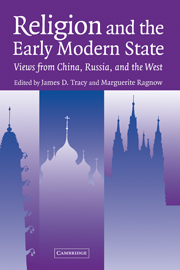Book contents
- Frontmatter
- Contents
- Contributors
- Acknowledgments
- Preface
- Religion and the Early Modern State
- Introduction
- PART I LIVED RELIGION AND OFFICIAL RELIGION
- 1 The Alternative Moral Universe of Religious Dissenters in Ming-Qing China
- 2 Ecclesiastical Elites and Popular Belief and Practice in Seventeenth-Century Russia
- 3 The State, the Churches, Sociability, and Folk Belief in the Seventeenth-Century Dutch Republic
- 4 Communal Ritual, Concealed Belief: Layers of Response to the Regulation of Ritual in Reformation England
- PART II FORMS OF RELIGIOUS IDENTITY
- PART III THE SOCIAL ARTICULATION OF BELIEF
- AN EPILOGUE AT THE PARISH LEVEL
- Selected Annotated Bibliography of Secondary Works
- Index
3 - The State, the Churches, Sociability, and Folk Belief in the Seventeenth-Century Dutch Republic
Published online by Cambridge University Press: 23 May 2010
- Frontmatter
- Contents
- Contributors
- Acknowledgments
- Preface
- Religion and the Early Modern State
- Introduction
- PART I LIVED RELIGION AND OFFICIAL RELIGION
- 1 The Alternative Moral Universe of Religious Dissenters in Ming-Qing China
- 2 Ecclesiastical Elites and Popular Belief and Practice in Seventeenth-Century Russia
- 3 The State, the Churches, Sociability, and Folk Belief in the Seventeenth-Century Dutch Republic
- 4 Communal Ritual, Concealed Belief: Layers of Response to the Regulation of Ritual in Reformation England
- PART II FORMS OF RELIGIOUS IDENTITY
- PART III THE SOCIAL ARTICULATION OF BELIEF
- AN EPILOGUE AT THE PARISH LEVEL
- Selected Annotated Bibliography of Secondary Works
- Index
Summary
From the outset, any reflection on religion and the state in the early modern Netherlands is confronted with some major conceptual problems. In the perception of many seventeenth-century Netherlanders, the state was multiform, and at times vanishing. Similarly, the historical concept of state religion is inappropriate for that country and period. Besides, more perhaps than in most other European countries, there is reason to distinguish for the United Provinces, at least analytically, between religion, church, and belief.
DEFINITIONS
It might be useful to propose some working definitions. Religion is meant here as the whole field of more or less intuitive forms of symbolic agency and interpretation of natural and human reality, prior to intellectual reflection and to “rational” organization (whatever rationality that may be), but from the intimate conviction that there is something beyond visible reality. Forms of magic may pertain to religion, just like the recourse to healing saints, and other elements of what currently is called “popular religion.” Belief is the intellectual legitimation and/or the emotional motivation of religion, centered around a personal or a joint encounter with God, as the ultimate reason of being. The social organization of religion refers to church (or its equivalents): the church is the sociocultural framework that enables belief to be organized in socially meaningful ways of thinking, ritual expressions, and norms and values for group behavior. Whereas religion stands for symbolics and ritual acting, church stands for its streamlining and legitimation into liturgy.
- Type
- Chapter
- Information
- Religion and the Early Modern StateViews from China, Russia, and the West, pp. 80 - 97Publisher: Cambridge University PressPrint publication year: 2004
- 1
- Cited by

